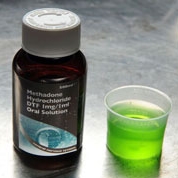Methadone

Description
Methadone is the mainstay of drug treatment in the UK. Recently some practitioners have returned to the 80s mantra that maintaining anyone on opiates/opioids rather than trying to detoxify them is merely trading one addiction for another. Consequently, these people tend to focus most of their frustrations on methadone.
There are plenty of research papers from all across the world supporting methadone, and it is undeniably effective for a very large number of people who are able to rebuild their lives while on long-term maintenance ‘scripts.
It can also be used as a short term community based reducing dose detox therapy (in which context it is rather less successful). Methadone is less sedating than heroin and offers less of a ‘high’. It has a very long half-life (usually over 24 hours) and consequently can be used once daily (although some users will split their daily dose into two).
Anecdotally, there is some evidence that heroin users disappointed with the effect of methadone may gravitate towards ‘potentiators’ (other substances that increase the ‘buzz’, such as alcohol, gabapentin, or a benzodiazepine like temazepam). This dynamic is hardly unique to methadone, but again, its prominence ensures that these issues are not ignored.
There are a number of health considerations that often occur when methadone is discussed – tooth decay (a sugar free version is available), libido (absolutely-most opioids and opiates reduce the sex drive in the medium/long term) and somatic (bone) pain or calcium deficiency (limited evidence from a research but strong anecdotal evidence from users).
